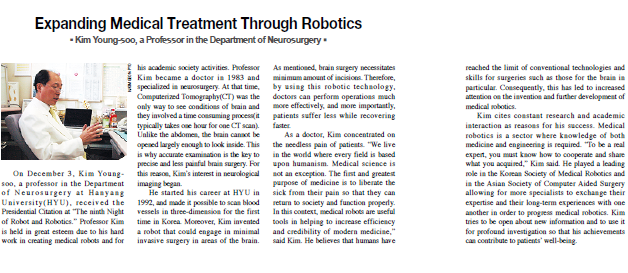
On December 3, Kim Youngsoo, a professor in the Department o f N e u r o s u r g e r y a t H a n y a n g University(HYU), received the Presidential Citation at “The ninth Night of Robot and Robotics.” Professor Kim is held in great esteem due to his hard work in creating medical robots and for his academic society activities. Professor Kim became a doctor in 1983 and specialized in neurosurgery. At that time, Computerized Tomography(CT) was the only way to see conditions of brain and they involved a time consuming process(it typically takes one hour for one CT scan). Unlike the abdomen, the brain cannot be opened largely enough to look inside. This is why accurate examination is the key to precise and less painful brain surgery. For this reason, Kim’s interest in neurological imaging began.
He started his career at HYU in 1992, and made it possible to scan blood vessels in three-dimension for the first time in Korea. Moreover, Kim invented a robot that could engage in minimal invasive surgery in areas of the brain. As mentioned, brain surgery necessitates minimum amount of incisions. Therefore, by using this robotic technology, doctors can perform operations much more effectively, and more importantly, patients suffer less while recovering faster.
As a doctor, Kim concentrated on the needless pain of patients. “We live in the world where every field is based upon humanism. Medical science is not an exception. The first and greatest purpose of medicine is to liberate the sick from their pain so that they can return to society and function properly. In this context, medical robots are useful tools in helping to increase efficiency and credibility of modern medicine,” said Kim. He believes that humans have reached the limit of conventional technologies and skills for surgeries such as those for the brain in particular. Consequently, this has led to increased attention on the invention and further development of medical robotics.
Kim cites constant research and academic interaction as reasons for his success. Medical robotics is a sector where knowledge of both medicine and engineering is required. “To be a real expert, you must know how to cooperate and share what you acquired,” Kim said. He played a leading role in the Korean Society of Medical Robotics and in the Asian Society of Computer Aided Surgery allowing for more specialists to exchange their expertise and their long-term experiences with one another in order to progress medical robotics. Kim tries to be open about new information and to use it for profound investigation so that his achievements can contribute to patients’ well-being.
이 기사를 공유합니다

